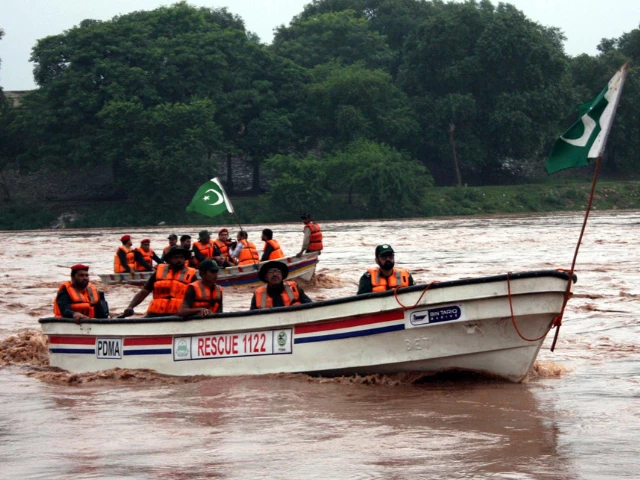In response to severe floods in the Nanowal district, the local administration has sought assistance from the Pakistan army, since the growing waters of floods continue to flood large stripes in the region.
The flood has been caused by the discharge of approximately 250,000 cusecs of water from the Ravi River in Kot Nainan, immersing vast extensions of agricultural and residential lands. Simultaneously, high levels of water in the Nullah Dek have added to devastation, putting more pressure on local aid efforts.
The planning minister, Ahsan IQBAL, in a position on X on Tuesday, said that the situation in the District of Narko had reached emergency levels. He confirmed that although the district administration actively participated in relief and rescue operations, the severity of the crisis required the deployment of the army staff.
ضلع نار Ogotar اس وقت شدید سیلابی صورتحال سے دوچار ہے۔ کوٹ نیناں کے پر دریائے راوی میں سو them طغیانی جاری ہے۔
ضلعی ان omine میہ امدادی کارروائیوں میں مصروف ہے، ident
– Ahsan Iqbal (@betterpakistan) August 26, 2025
“The administration is working on the field, but the seriousness of the floods has led us to request the support of the Pakistan army,” he said. He urged citizens to remain attentive, avoid unnecessary movement in affected areas and prioritize their safety. The minister also announced that he was heading to Nanowal to evaluate the situation in the field.
Meanwhile, the Provincial Authority for Disaster Management (PDMA) warned that the province, including the main city of Lahore, faces a very high flood danger except for exceptionally high “, driven by the heavy rains of the monsoon and the decision of India to discharge water from two dams.
According to the PDMA, India had opened all the doors of the Dam Thein, releasing surplus water to Ravi. This development followed a warning issued the previous day with respect to a possible discharge of the Madhopur dam that fills rapidly, which also affects the Ravi River system.
“The situation of the flood is serious,” said Irfan Ali Kathia, an official of the Punjab Disaster Management Authority. “The next 48 hours will be critical.”
Read more: PM orders rapid evacuations as floods affect Sutlej, Ravi and Chenab
The National Disaster Management Authority (NDMA) previously evaluated that satellite images showed that Thein’s dam was already full of 97%, a level in which the water discharge becomes imminent.
India regularly performs these releases when the deposits exceed the capacity; However, the proximity of the two nations with nuclear weapons and persistent tensions after the conflict have increased sensibilities. Any flood attributed to Indian actions could further tighten fragile relations.
A source from the Indian government clarified that the second alert did not refer to a specific dam. The intense rain, added the source, had caused renewed communication with Pakistan through diplomatic channels, apparently for humanitarian reasons to help avoid a disaster that affects both countries.
Ongoing mass evacuations
The authorities have increased evacuations: more than 190,000 residents in Punjab have been displaced, including almost 35,000 that voluntarily left after flood warnings began on August 14, according to national officials.
The villages are being cleared near the Ravi, Sutlej and Chenab rivers, with the help of the army. While the current floods along these rivers range from the middle to high, an additional heavy rain is expected between Punjab and Pakistani Kashmir in the next 12-24 hours.
“Sixteen villages remain at risk of immediate flooding,” said the attached commissioner Saba Asghar Ali during a visit to Pasrur near the Indian border. Socorro camps with supplies for food, medicine, sanitation and other needs have been established.
Punjab irrigation minister Kazim Raza Pirzada observed that “climate change has intensified the rain in our Eastern River basins compared to the past.”
PMD forecasts persistent rain, flood risks
The Department of Meteorology of Pakistan (PMD) predicts on Wednesday generalized rain, wind and thundershowers in the northeast of Punjab and Kashmir, with isolated rains that are expected in other places in the center and south of Punjab, the height of Khyber-Pakhtunkhwa, and the northeast and the south of Baluchist.
Heavy downpours can trigger landslides and landslides in mountainous areas of Kashmir, including Rawalakot, Ponch and Mirpur, and urban floods in low cities such as Narowal, Sialkot, Gujranwala and Lahore.
Residents have been urged to remain cautious, since intense climate can affect weak structures, posts, advertising fences and vehicles.
In response to the growing threat, the Punjab Police Inspector, Dr. Usman Anwar, placed police force on a maximum alert. He directed teams from all over the province to help in rescue and evacuation operations, particularly in low and flood prone to floods that border rivers and streams.
Supervision officers (RPO and DPO) have personally had the task of supervising land efforts, closely coordinating with the district administrations and rescue agencies.
Regular patrol is underway in the affected areas, and the police guarantees the safety of relief camps and people displaced by floods. “The protection of the lives, property and essential belongings of citizens will be guaranteed at all costs,” said the PGI.
Since the monsoon began at the end of June, deaths related to floods in Pakistan have reached 802, and almost half occurs only in August. Other regions are similarly affected; Gilgit-Baltistan is dealing with the accelerated glacial fusion, and Karachi was partially submerged by sudden floods last week.




